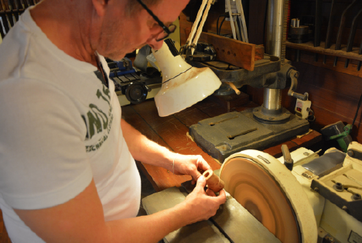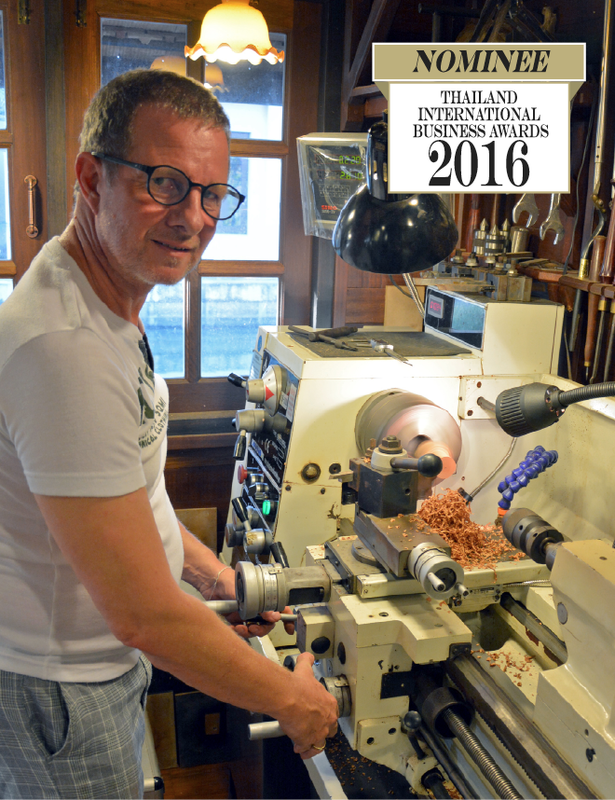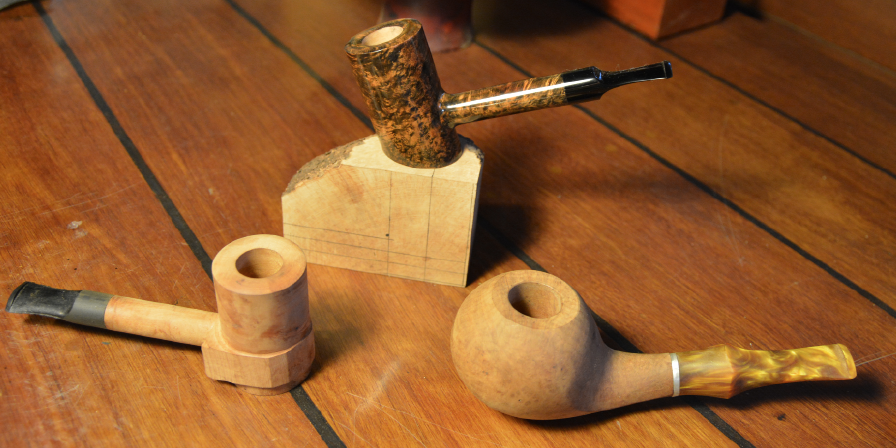Entrepreneur: Carsten Fischer
By Colin Hastings
| UP until the early 1960s, smoking a pipe was the must-do pastime of politicians, military types, philosophers, professors and even sportsmen. It was very cool, the sign of a deep thinker. Then pipe smoking’s popularity went into a rapid decline, a victim of its quaint, avuncular image and the anti-smoking lobby. But like most fads and fashions, pipes have gone the full circle and are making a comeback. Who says so? Carsten Fischer, a 56-year-old Dane who’s made Bangkok his home for the past 15 years. And he should know, for Carsten is this country’s only full-time pipe-maker whose beautiful hand-crafted products are currently in demand around the world. |

In the tiny but efficient workshop he’s built in the garden of the house he shares with his Thai wife, a fortune teller and seller of selective mobile numbers, and their young daughter, Carsten beavers away hour after hour, often forgetting the time of day or night, skillfully creating an amazing array of pipes to suit the individual preferences of this new and enthusiastic generation of smokers.
In Thailand – his biggest market – buyers include architects, police and army officers, government officials and ordinary folks who have acquired a taste for pipe-smoking. Most of his overseas buyers are from Europe, especially Germany, as well as aficionados in Australia, Chile and Japan.
“Demand is definitely increasing,” notes Carsten, whose dedication to his job is not merely a marvel but a virtual obsession. “I can go weeks without leaving the house, partly because of the number of orders I’ve received but also because I love what I’m doing.”
Before coming to Thailand, Carsten was involved in the garments industry, his company adding screen prints and embroidery on jackets and T-shirts to sell mainly for promotional purposes and gifts. The work took him every month to Bangladesh, where he oversaw the factory operation.
On the way back to Denmark, he would spend a couple of nights relaxing in Bangkok. After a decade or so, Carsten had tired of this long distance commuting and decided to sell off his company, opting to settle in Thailand “for a better life” rather than returning home.
Looking around for something to occupy his mind and time, Carsten initially tried his hand at traditional pottery. After this proved too complicated and impractical, he switched his attention to two of his great loves at that time – pipe smoking and wood.
“I had been a pipe smoker for 40 years, and I had this passion for wood, so I put them together and came up with this idea to make pipes.
“I did a lot of research to find the right kind of machines, and after building my workshop I practised for an entire year by making wooden bowls from mango wood. Only then did I feel confident about making wooden pipes.”
In Thailand – his biggest market – buyers include architects, police and army officers, government officials and ordinary folks who have acquired a taste for pipe-smoking. Most of his overseas buyers are from Europe, especially Germany, as well as aficionados in Australia, Chile and Japan.
“Demand is definitely increasing,” notes Carsten, whose dedication to his job is not merely a marvel but a virtual obsession. “I can go weeks without leaving the house, partly because of the number of orders I’ve received but also because I love what I’m doing.”
Before coming to Thailand, Carsten was involved in the garments industry, his company adding screen prints and embroidery on jackets and T-shirts to sell mainly for promotional purposes and gifts. The work took him every month to Bangladesh, where he oversaw the factory operation.
On the way back to Denmark, he would spend a couple of nights relaxing in Bangkok. After a decade or so, Carsten had tired of this long distance commuting and decided to sell off his company, opting to settle in Thailand “for a better life” rather than returning home.
Looking around for something to occupy his mind and time, Carsten initially tried his hand at traditional pottery. After this proved too complicated and impractical, he switched his attention to two of his great loves at that time – pipe smoking and wood.
“I had been a pipe smoker for 40 years, and I had this passion for wood, so I put them together and came up with this idea to make pipes.
“I did a lot of research to find the right kind of machines, and after building my workshop I practised for an entire year by making wooden bowls from mango wood. Only then did I feel confident about making wooden pipes.”
Today, he is thoroughly comfortable in his chosen trade, a craftsman with an eye for detail and a passion for perfection.
Like other pipe makers, Carsten mostly uses pieces of imported root from a tree known as the Briar. Grown in Italy, Greece and France, this wood is ideally suited for the job. Light to reddish brown in colour, it is beautifully textured, extremely hard, heat-resistant and does not affect the aroma of pipe tobacco smoke. It is also used for making jewellery and knife handles.
“For the smoker, there’s no taste of the Briar root – unlike, say, olive wood, which would leave a taste of olive. It’s perfect for smoking pipes.”
Conjuring a handsome object like a pipe from a solid block of wood is unimaginably complex. “It involves up to 200 individual procedures,” explains Carsten, who by choice works completely alone. “I have no staff so I can say I produced every pipe myself. No other hand has featured in its creation.”
The process starts with selecting a design. “We have over 180 to choose from, including traditional designs like the Poker, Full Bend and Billiard, and non-traditional ones like the Horn.
“We also advise buyers on things like the size of the tobacco chamber, which is different in cold countries compared to hot countries.
“When all that’s done, we draw the design on a computer. Then we select the wood block, prepare it and then draw the pipe’s design on the block itself.”
In the kind of workshop that every boy wants when he grows up and every man wants so he can recall his youth, Carsten uses lathes, saws, grinders and sanders to produce the basic shape of the pipe. These can range from a short and stubby pipe to long, curvy and elegantly slim varieties. The shape of the tobacco chamber comes in a number of different shapes and sizes too.
Umpteen other steps are then required to complete the shaping. At every step, Carsten studies his workmanship closely, touching, stroking and feeling it for the perfect finish. Finally, the pipe is sanded, stained, polished and waxed to produce all kinds of textures. Later the logo and number are engraved on the underside. Each pipe is unique and can take from eight to 25 hours to complete.
Apart from actually making pipes, he also repairs broken pipes that owners apparently can’t bear to be separated from.
Carsten’s pipes are not cheap, ranging in price from 5,000 to 28,000 baht. Apart from buyers who visit his house and workshop, his VaVa pipes are sold exclusively through a ground floor shop in Seacon Square.
One of the biggest challenges facing pipe smokers in Thailand is sourcing supplies of quality pipe tobacco. “Half my emails are from people wanting to know where to buy tobacco. ‘Nowhere’ is always my reply,” says Carsten, who then admits he occasionally suggests that small quantities are usually available via the Internet.
Although he no longer smokes a pipe himself for “health reasons,” he remains passionate about the pastime. “There’s something very romantic about pipe smoking – it’s almost a religion.
“Pipe smokers are a special kind of person. They’re like me, relaxed, happy people, who enjoy life and can sit for hours, no problem. Smoking a pipe can’t be rushed.”
www.vava-pipe.comU
Like other pipe makers, Carsten mostly uses pieces of imported root from a tree known as the Briar. Grown in Italy, Greece and France, this wood is ideally suited for the job. Light to reddish brown in colour, it is beautifully textured, extremely hard, heat-resistant and does not affect the aroma of pipe tobacco smoke. It is also used for making jewellery and knife handles.
“For the smoker, there’s no taste of the Briar root – unlike, say, olive wood, which would leave a taste of olive. It’s perfect for smoking pipes.”
Conjuring a handsome object like a pipe from a solid block of wood is unimaginably complex. “It involves up to 200 individual procedures,” explains Carsten, who by choice works completely alone. “I have no staff so I can say I produced every pipe myself. No other hand has featured in its creation.”
The process starts with selecting a design. “We have over 180 to choose from, including traditional designs like the Poker, Full Bend and Billiard, and non-traditional ones like the Horn.
“We also advise buyers on things like the size of the tobacco chamber, which is different in cold countries compared to hot countries.
“When all that’s done, we draw the design on a computer. Then we select the wood block, prepare it and then draw the pipe’s design on the block itself.”
In the kind of workshop that every boy wants when he grows up and every man wants so he can recall his youth, Carsten uses lathes, saws, grinders and sanders to produce the basic shape of the pipe. These can range from a short and stubby pipe to long, curvy and elegantly slim varieties. The shape of the tobacco chamber comes in a number of different shapes and sizes too.
Umpteen other steps are then required to complete the shaping. At every step, Carsten studies his workmanship closely, touching, stroking and feeling it for the perfect finish. Finally, the pipe is sanded, stained, polished and waxed to produce all kinds of textures. Later the logo and number are engraved on the underside. Each pipe is unique and can take from eight to 25 hours to complete.
Apart from actually making pipes, he also repairs broken pipes that owners apparently can’t bear to be separated from.
Carsten’s pipes are not cheap, ranging in price from 5,000 to 28,000 baht. Apart from buyers who visit his house and workshop, his VaVa pipes are sold exclusively through a ground floor shop in Seacon Square.
One of the biggest challenges facing pipe smokers in Thailand is sourcing supplies of quality pipe tobacco. “Half my emails are from people wanting to know where to buy tobacco. ‘Nowhere’ is always my reply,” says Carsten, who then admits he occasionally suggests that small quantities are usually available via the Internet.
Although he no longer smokes a pipe himself for “health reasons,” he remains passionate about the pastime. “There’s something very romantic about pipe smoking – it’s almost a religion.
“Pipe smokers are a special kind of person. They’re like me, relaxed, happy people, who enjoy life and can sit for hours, no problem. Smoking a pipe can’t be rushed.”
www.vava-pipe.comU



 RSS Feed
RSS Feed



